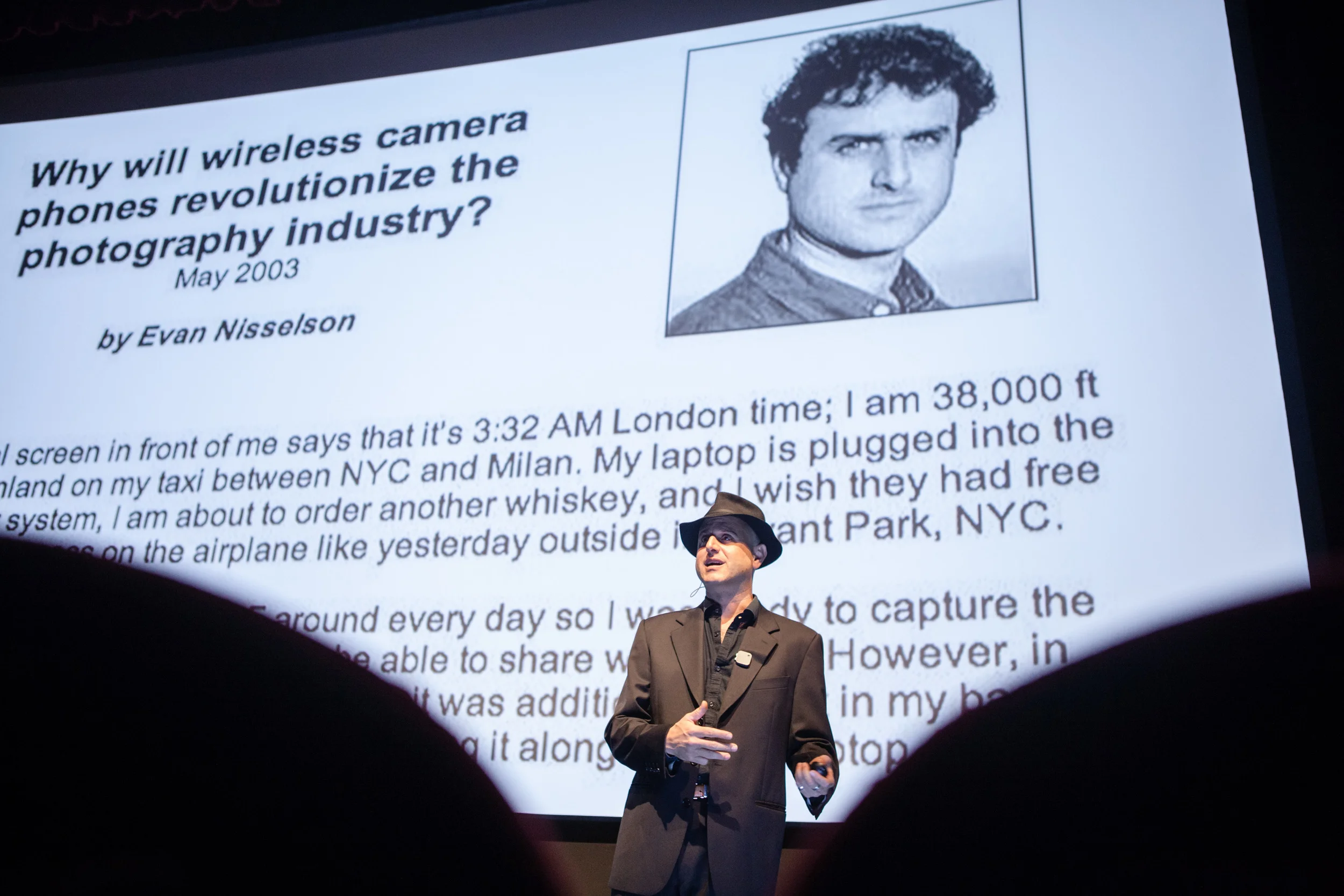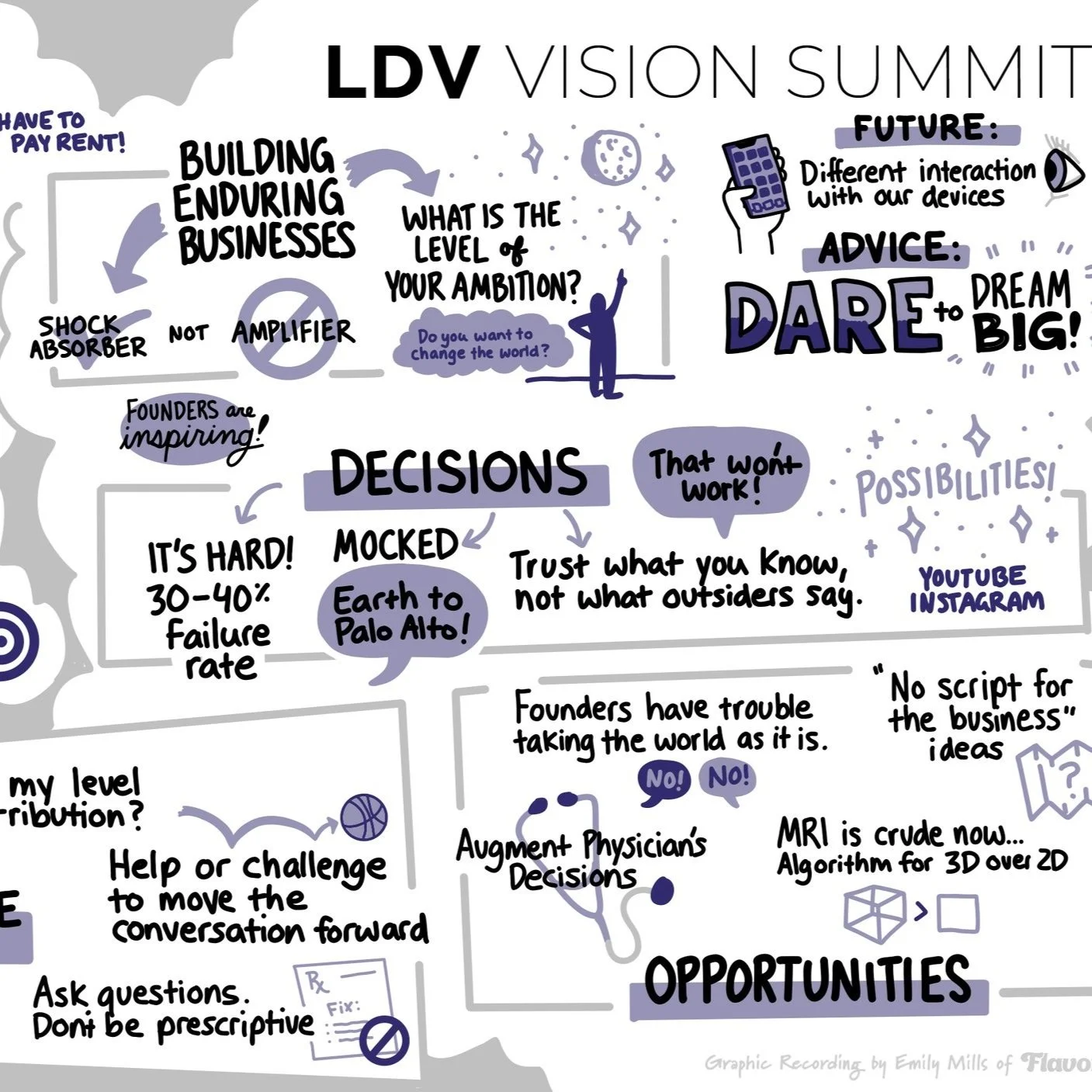Visual Technologies Are Revolutionizing Humanity And Business
/Every year, we bring together an impressive lineup of speakers – from tech giants to under-the-radar startups, esteemed research labs and leading venture capital firms. Come join our 12th Annual LDV Vision Summit on March 11, 2026.
Evan Nisselson, LDV Capital ©Robert Wright/LDV Vision Summit
This article is an excerpt from our LDV Vision Book 2015.
Visual Technologies are revolutionizing humanity and business around the world like never before. People spend an unbelievable majority of their time every single day with technologies that help them make sense of what’s going on around them, capture the moments that matter to them, and figure out how they get from point A to point B. What’s unique now in the world of technology and the Internet is the evolution of higher bandwidth, Cloud computing, real-time data, and mobile devices that are allowing people to capture exponentially more visual content. Whether it be images or video—this is drastically changing how people communicate with each other. Instead of going to the dentist and texting someone that you just went to the dentist, you send a picture of yourself at the dentist. While on vacation, you don’t just write an email telling your friends about your vacation. You post an image of the beach on Facebook or post what you ate that night on Instagram. You capture video of a beautiful event, like a wedding or a birthday, to preserve the moment so you can relive it later or share it with others.
Now in its second year, the annual LDV Vision Summit is all about gathering the key people in our ecosystem at one event to hear their wisdom and advice on how humanity and business will be impacted by new technologies and companies in the visual imaging world. We gather the five different categories of people—from startups, investors, computer vision and AI experts, media and brand execs, and creators—to come together to network, do deals, explore and inspire, and find co-founders to build businesses. It’s all about empowering the people building the visual revolution.
The ideas and lessons from the LDV Vision Summit live on long after the event concludes via different mediums as we know everyone has different content viewing tastes. We capture videos from the event which are available online and we are also very happy to be putting together this second LDV Vision book.
What is visual technology? Visual technology is any technology that captures, organizes, filters, learns from, or distributes visual content either for consumers or businesses. It’s a horizontal focus across all business sectors and humanity. How will these technologies impact everybody’s lives, in work, and in play? If you look across different industries, these examples cover a wide range of sectors that visual technology impacts, from personal to business, and sub-sectors of medical, financial, sentiment analysis in advertising, in publishing, in shopping, autonomous cars, and so on. There are so many examples of visual technology affecting our world today, you may not even realize it. Facebook couldn’t exist without images and videos. There’s been a lot of discussions recently about self-driving cars. Self-driving cars would not exist without many cameras in and around the car telling us where the pedestrians are, where other cars are, where the curb is, and how fast the car should be going. That’s an unbelievable evolution in leveraging visual content, not only to communicate visually but to help us be safer in day-to-day activities. The mission of the LDV Vision Summit is to bring together—in a unique way—the men and women who work in this world and who together represent the whole ecosystem of visual imaging, but who don’t typically sit in the same room.
One of the things that’s extremely rewarding and unique about our Summit is that there’s no other event that brings together those five categories of people to one place. It’s challenging because they all have different needs, but what’s unique is the serendipity of everybody coming to one place. Over the last two events we’ve had, there have been at least 10 to 15 companies that have raised significant funding after being highlighted at our Summit. There are several people that have been recruited by technology companies after meeting at the Summit. There are several technology service deals with media companies that have been inked because of the Summit. Some people have joined together to build new companies and also a multitude of investment opportunities. We’ve invested in a couple from the Summit, and we look forward to investing in more. That core of serendipity of opportunity is the foundation for why we put this together, in addition to inspirational and educational benefits.
I’ve been building businesses and visual technologies since the mid ’90s, and prior to that I was a professional photographer and a photo agent. What’s fascinating is that in the ‘90s, because of the bandwidth and other bottlenecks, it was harder. There were no phones with high-quality cameras. No one was walking around making photos with camera phones or iPads. It was a very slow evolution. It continued to be slow until the mid 2000s, and I think in the last five years the pace started to move faster, mainly because of the high growth of adoption of smartphones with cameras and smaller devices using hands-free cameras. Things have exploded. Take GoPro, for example.
Everybody who is doing extreme sports is using a GoPro. However, with this exponential growth of content, it’s actually making it harder and harder to decipher and discover the signal through the noise. I’d say 99.9% of the content that’s created and shared is not high-signal or high-quality content. One significant challenge is to figure out the single video or single video frame that’s contextually relevant to me and at the contextually right time, so that I can enjoy watching it on any device. In the last five years, the industry has grown exponentially following the evolution and growth of mobile devices. I think we’re just at the beginning of that growth. We cannot even imagine how many more ways there will be for us to capture, create, share, and visually communicate with content.
We talk about exponential growth of capturing and of creating but the real core that is going to make this exponential growth of visual content valuable is machine intelligence, computer vision, deep learning, and artificial intelligence, which can now contextually filter what’s relevant for us at the right time. As we create more and more visual content, we’re becoming overwhelmed with everything available to us. How can we make sense of it all? Because of Cloud computing and advancements in machine intelligence, we are seeing tremendous progress and opportunity. Facebook, Twitter, Google, Apple, Dropbox, Qualcomm, Intel, Microsoft, Shutterfly, and other major players are building up huge departments for machine learning by acquiring companies and teams in that space. They realize the need for filtering the signal through the noise.
All technology impacts live for good and for bad. It’s all a matter of perspective. 20 years ago I was working at an early-stage startup called @Home Network, and I was working around the clock in front of my computer buying all these devices and saw very early how it was going to impact people’s lives. When a couple of us created the first broadband photo community in 1997 at @Home Network called Making Pictures as a $3 million joint venture with Intel, everybody thought I was crazy. Everybody said, “I don’t want to make digital photos. That’s a horrible thing. I want negatives, and I want to go to the darkroom.” The point of whether or not a technology is good or bad evolves with our evolution of technology and humanity. I’d rather spend more time on creativity and helping entrepreneurs build successful businesses than doing a lot of the menial stuff that doesn’t intrigue me, entertain me, or is in my mind a waste of time. One person’s favorite service is another person’s bane of their existence.
A big theme of this year’s Summit was satellite imaging, which is something that we’ll talk about a lot here. More and more satellites are being put in the air and more and more have high-definition cameras. Not only will this impact businesses and lead to the creation of new billion-dollar businesses, but satellite imaging is going to be able to move financial markets as well. Now we can actually track how many cars are in a parking lot at Walmart or Home Depot and compare the two in real-time rather than months later after manual research. We can identify the abundance or lack of oil reserves from the sky. We can monitor traffic and track trends for busy roadways. We can track how popular or how active shipping ports are. We can count how many containers are on a ship, how many cars are in the port, and how fast they’re moving in and out of the shipping ports.
To take it to the next level: Sure, we have camera phones and we have flying cameras attached to drones—but when will we have satellite selfies? Let’s back up a second. You can take a selfie with your camera phone. You can take a selfie with a selfie-stick. You can take a drone selfie, which is called a “delfie.” There’s a “jelfie,” which is a jumping selfie. Soon there’s going to be a satellite selfie, where you’ll be able to touch your smartphone, look up into the sky and a satellite will make a picture for you. Obviously there are technical hurdles that we have to get through, but it will happen in our lifetime. You’ll be able to tap your smartphone, grab your friend or significant other, look up, and the satellite will take a picture of you. Maybe soon you won’t even have to carry your camera phone around or take any pictures because you can say, “I want this picture” and in two seconds it will be captured by a security camera, a drone, or a satellite camera.
Obviously, there are bandwidth issues from the satellite. Obviously, there are delays from the satellite, and the quality is not yet good enough to see the freckles on your face—yet. However, the military forces are actually using satellite cameras that can read a paper in your hand. This technology is happening, but there are still a lot of questions and I don’t have all the answers. That’s why we gather the experts at the annual Vision Summit and in this book, so we can help inspire others about how visual technologies are impacting our lives for better or for worse.
Machine intelligence has great impacts on the medical world, too. Why is it that we go to the doctor for an x-ray and the radiologist only looks at three x-rays from that one visit? Imagine if they could look at the x-rays from our whole life and see trends? Even better, why don’t they look at millions of anonymous x-rays to better understand whether what we have is something serious? What about skin cancer? There are several companies that are starting to create cameras that can photograph moles or different pieces of your skin so that you actually can send that to a doctor in advance of having a doctor’s appointment. What about mammography? We can look at hundreds of mammogram photos to understand trends in these medical scans, helping radiologists be exponentially more efficient at seeing potentially problematic patterns. That can’t be done unless we’re leveraging computer vision and machine intelligence.
This potential for analysis of visual content—contextualizing, organizing, using it to predict and identify trends—is a maturation of visual technology that allows us to transition these tools from industrial applications to mass consumer use. This year, we saw tools for advertisers to analyze consumer content via facial expressions through sentiment analysis thanks to companies like Emotient and Affectiva. We learned about face recognition doorbells, exciting developments in 3D printing technology—like a custom-fitted insole—and Microsoft’s hologram headsets. There’s the interactive video experience from WIREWAX and Sphericam’s 360-degree video camera that’s taking adventure photography to the next level.
The purpose of this book is to capture the most important ideas from the Summit so they are not lost once the event is over and to explore the latest thinking in everything from computer vision to AI to deep learning to augmented reality. During the 2015 LDV Vision Summit, we assembled 80 speakers from many countries around the world to take part in this two-day meeting of the minds in New York City. This written document of the sessions, presentations, and conversations that took place there is our attempt to preserve the knowledge and wisdom from those we brought together so that others can learn, innovate, and create. The book is broken up into themed sections, and what’s really fascinating and unique about the group of people assembled here is the wide range of visual technologies that are represented across such a broad spectrum. I think that’s the most exciting, most challenging, and will deliver exponential returns for everyone involved and who reads this book—hopefully for happiness, health, and financial benefit.
I have always been fascinated by and passionate about visual computing and visual communications, since getting my first Nikon FM camera at 13 years old. I’ve been a professional photographer, 18 years of building businesses within this visual technologies sector, and an investor for more than three years at LDV Capital. What excites me, even more, is that I don’t have all the answers. I never have all the answers. I love surrounding myself with others who might have the answers and collaborating with them to figure things out, to be inspired, to learn.
That’s the core of why several of us have worked together to bring the LDV Vision Summit to life so that it can empower the world to learn, inspire, and create. Hopefully, each and every one of you will have your own benefits, whether or not you’re an expert, whether or not you love photography or video, whether or not you’re thinking about being an entrepreneur or you’re a computer vision expert and you want to figure out how to build a business rather than studying how to write grants for the rest of your life. There’s a piece of the puzzle for everybody here, and I hope you enjoy the wisdom of all of our speakers in this book.













